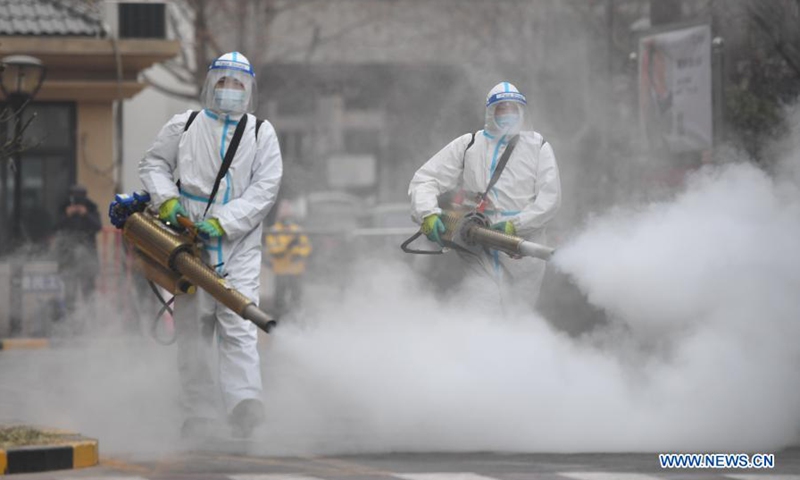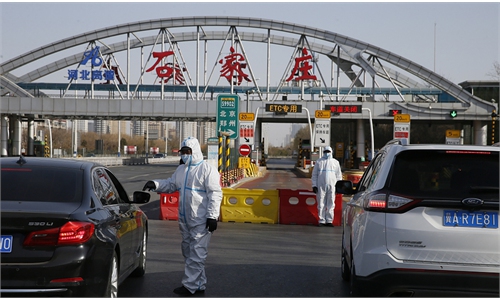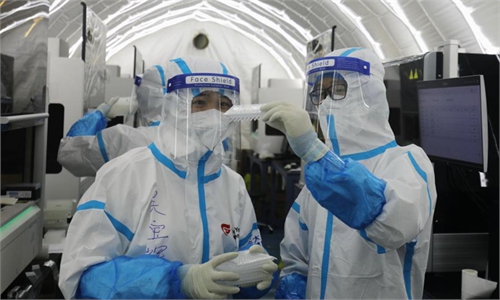
Staff members spray disinfectant at a residential community to prevent the spread of COVID-19 in Yuhua District, Shijiazhuang, north China's Hebei Province, Jan. 24, 2021. (Xinhua/Zhu Xudong)
Shijiazhuang, capital city of North China's Hebei Province, largely ended its lockdown on Friday, with residential communities and villages with no COVID-19 cases starting to resume social activities and industrial enterprises resuming production in an orderly manner.
A Shijiazhuang resident, surnamed Zhang, in Yuhua district told the Global Times on Sunday that he waited for about an hour on Saturday night to have a haircut as he prepares to resume work. "It's the first time seeing so many people in nearly a month," he said, noting that almost everyone seen on the street is wearing a mask.
"This is impressive, because we had almost been off guard and already stopped wearing masks before the resurgence in the city," he said, noting that the residential community he lives also issued entry passes on Saturday to step up prevention measures.
He said the local government now encourages the use of private vehicles, with traffic restrictions based on the last digit of license plate numbers having been removed. "Today, traffic on the road has seen an apparent increase compared with Saturday," Zhang said.
On the same day, a local resident, surnamed Li, returned to her home in Zhengding district, Shijiazhuang, the first time in more than 20 days, as she has been under lockdown at the site of her company, which is engaged in the research and production of semiconductors, since January 6. "Our company's manufacturing didn't stop during the period, because most workers at home returned to the factory in time prior to lockdown and live in the company's dormitory," Li said.
Many other large enterprises in key industries - including pharmacy and steel - took the same measures to ensure continuous manufacturing during the lockdown.
A manager with traditional Chinese medicine producer Shijiazhuang Yiling Pharmaceutical Co, supplier of Chinese herbal product Lianhuaqingwen, told the Global Times that the company stepped up coronavirus-prevention measures at the factory, arranged accommodation for workers in the office area and offered sufficient anti-outbreak supplies to guarantee manufacturing while strengthening protection.
"The production of anti-virus products such as Lianhuaqingwen Capsules is normal, with daily capacity rising to 4 million boxes," said the source.
A source with Delong Steel Ltd in Xingtai, where the situation was also severe, told the Global Times on Sunday that the company's manufacturing wasn't suspended during the lockdown, but output capacity was lowered due to raw material shortages. "We haven't fully recovered, because some suppliers are unwilling to transport raw materials, as there is still a high-risk region in Xingtai," he said.
According to the Shijiazhuang government, the resumption rate of industrial enterprises above designated scale in the provincial capital reached 40.6 percent, of which that in low-risk counties reached 63.4 percent by Saturday noon.
Liu Shengyan, head of the Shijiazhuang Bureau of Industry and Information Technology, said at a press conference on Saturday that the local government will boost business resumption with precise policies according to industries and risk levels.
Affected by sporadic infection resurgences across the country, the official manufacturing PMI dropped 0.6 month-on-month to 51.3 in January, while non-manufacturing PMI dropped 3.3 from the previous month to 52.4.
Tian Yun, vice director of the Beijing Economic Operation Association, told the Global Times that the drop is within expectations, mainly due to impact of the resurgence and a slight fall in the country's exports.
However, he estimated that infection resurgences will only drag down about 0.1-0.2 percentage points of economic growth, with year-round GDP growth rate for 2021 expected to be around 8.5 percent.



